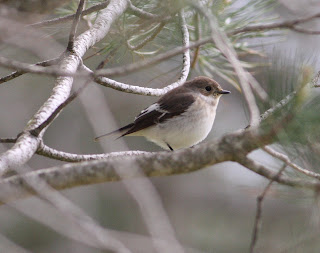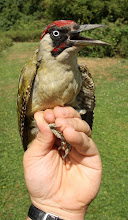Now that I'm back safely from Sardinia, I've started going through the photographs and thought I'd start with some of the stunning scenery that we saw. We flew into Cagliari in the evening and after staying one night there, we stayed at various locations on the east coast starting in the South East corner.
There was plenty to see and we certainly didn't have time to fit it all in, but the majority of the places we went were worth going back to!
Above: After a walk of just under 1 hour and 30 minutes to walk about 5km (it wasn't the hardest walk that we did) from the nearest car park, we got to the Gorge at Su Gorropu. We must have spent about an hour climbing over, around and under rocks inside the gorge (where Crag Matins, Grey Wagtails, Spotted Flycatchers and Blue & Great Tits were present). Local wildlife (though we didn't see them) included extremely rare flowers (i.e. only 20 - 40 existed in the world in only this location), Peregrines & Golden Eagles and Salamanders.
To completely navigate the gorge (1.5km long) would have been impossible without proper climbing gear and guides but the views we got were more than worth the walk and entrance fee.
I set a fast pace on the way back to the car (mostly down hill - I couldn't have done it uphill) and we made it back in 1 hour & 5 minutes. Some of the younger & fitter people we overtook (especially on the uphill sections), must have been stunned at our pace. My dad remarked that the pace I set was called 'parental abuse' - he managed it though!
Above: This is a spring at Su Gologone. Apparently 25,000 litres of water a second can come out of this spring - even more in times of flood! The water comes from deep under the mountains. After a gruelling trek to Mount Tiscali, this was a very nice bonus.
Above: We did the trek to Mount Tiscali the hard way and this is the view from an early part of the walk.
Without clear directions or map to follow (or clear signs - a real problem in Sardinia when trying to find places of tourist interest), we guessed at the best way to get there. The Sardinians would prefer that we pay proper guides to take us to Mount Tiscali but the reality is that this costs rediculous amounts of money and is largely unnecessary (unless you have money to waste and/or really need somebody else to make sure you get there). You do need to be quite fit though to constantly walk steeply up hill for an hour or more in the heat/sunshine.
Afterwards, we realised the way we chose was the most difficult and steepest!
Above: My dad climbing the route to Mount Tiscali! This was the steepest/worst bit. Had it been any steeper, rock climbing equipment would have been needed!
Although we weren't following a signed route, we were on a route that was clearly used and where landrover access finished, it was marked with piles of stones. However, with a lack of signs, we got a bit lost until we came across some Sardinian walkers who kindly showed us the way. Even then it was a long trek downhill (the opposite side of the mountain from where we started) before going up again! Thankfully we made it and the trek back was on a recognised route and all downhill.
In the UK, OS maps are far more detailed but we couldn't even rely on the Sardinian maps showing all the roads, let alone the footpaths!
Above: Another tough trek through the hillside, this time to an isolated beach called Cala Goloritze - you can see all but about 5 square metres of the beach in the photo. It is favoured by the yachting fraternity as this is an alternative and easier way to reach it! Apparently, it's a very crowded beach later on in the year, but being tiny - there's little wonder why! On the way back 'uphill' 2 Firecrests made a very welcome appearance! And upon return to the car park, I found a Wood Warbler!
We visited a number of tourist attractions such as Nuragic (bronze age) villages, beaches, gorges and springs and they mostly had this in common:
You either started your walk from high up and went down a long way and then back up afterwards or you started low down and went somewhere high up and then had to come back down again (the latter being easier).
All walks had hard rocks underfoot - except where we made it onto a beach that had sand!
Above: A peaceful & picturesque site.
Whilst making our (meandering) way to a specific Nuragic village, we stopped to eat our lunch at a scenic location (with so many around, stopping somewhere with little to see seemed silly). There were signs to a different Nuragic hillfort/burial place of some sort where we stopped and whilst investigating this, we stumbled across a lovely site with wild flowers, grassy areas and a variety of scrub, trees and rocks. It was like a landscaped garden only better and (presumably) natural - though there was a church and stone picnic benches around. The photograph really doesn't do it as much justice as it should.
In the peaceful surroundings of this site, I managed to see and photograph a Woodlark (the first for the holiday) and a Pied Flycatcher (2nd and last of the holiday).
Above: A beach at dusk near Villasimius in the South East of Sardinia. A very attractive beach and I think the sunset made it even better.
Above: The beach at Villasimius from above. Between the beach and the first strip of green (on the left) is an area of water where we found several Kentish Plovers. I have found that this species likes salt water environs, beaches and dunes.
You may have noticed the clouds in the last photograph - this was a regular feature of the holiday and on a couple of mornings, it rained. It was also very hazy, even when it was wall to wall sunshine. I think this was at least in part, due to the amount of dust/particles in the air as when it rained, it left a lot of dust on the car!
Photographs of some of the birds I saw will follow soon.







































